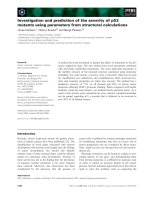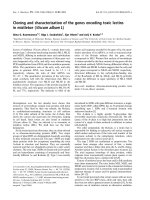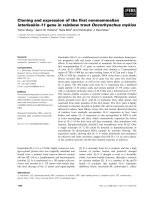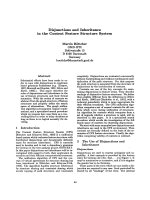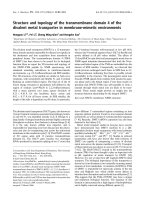Báo cáo khoa học: "Contents and evaluation of the first Slovenian-German online dictionary" doc
Bạn đang xem bản rút gọn của tài liệu. Xem và tải ngay bản đầy đủ của tài liệu tại đây (203.93 KB, 4 trang )
Contents and evaluation of the first Slovenian-German online dictionary
Birte Liinneker
Institute for Romance Languages
Hamburg University
Von-Melle-Park 6
20146 Hamburg, Germany
birte.loenneker@uni
-
hamburg.de
Prima Jakopin
Corpus Laboratory
F. R. Institute of Slovenian language
ZRC SAZU, Gosposka ulica 13
1000 Ljubljana, Slovenia
primoz.jakopin@uni—lj.si
Abstract
This paper presents the first Slovenian-
German and German-Slovenian online
dictionary and contains evaluation fig-
ures for its Slovenian part. Evaluations
are based on coverage of a Slovenian
newspaper corpus as well as on user
queries.
1 Introduction
The first Slovenian-German and German-
Slovenian online dictionary is available at
http ://www. stud.uni -h amburg. de/users/1
.
)i rte/slo
Its current version, which was completed in
November 2002, contains more than 4,800 entries
covering the content of a beginners' textbook for
Slovenian.
Section 2 gives some information about the con-
tents and structure of the dictionary. Section 3
evaluates the Slovenian part, based on its coverage
of lemmas in DELO, a Slovenian newspaper con-
tained in the
Nova beseda
corpus at ZRC SAZU
(Beseda, 2000) as well as on its ability to fulfill
user requests. Section 4 is the conclusion.
2 Contents and structure of the
dictionary
In November 2002, the Slovenian-German-
Slovenian online dictionary contained more than
4,800 entries which correspond to words, selected
' />word forms and expressions appearing in the text-
book
Odkrivajmo slovenkino,
a beginners' text-
book for Slovenian (C' uk et al., 1996). The entire
content of the textbook is covered.
The textbook is used in teaching Slovenian es-
pecially in German, French or Italian speaking
communities.
2
It contains Slovenian-only text, ex-
planations and exercises. As there is neither an in-
dex nor a vocabulary list, the online dictionary is
a valuable completion of this educational material.
However, it can be — and actually is — used inde-
pendently of the textbook.
The current version of the online dictionary
contains the following elements, based on
Odkri-
vajmo slovenkino:
•
all lemmas appearing in the texts, explana-
tions, instructions and exercises;
•
irregular inflected forms as well as the first
person singular form of verbs;
•
common conversational phrases and multi-
word expressions as well as some contextual
examples of words and grammatical forms.
Grammar information for both languages and
information on stressed syllables for the Slovenian
entries are contained in additional fields. For both
languages, three different kinds of search are pos-
sible:
2
Personal communication from Meta Lokar, Centre for
Slovenian as a Second/Foreign Language, University of
Ljubljana.
119
1.
exact match
3
;
2.
match a text string as a part of the dictionary
entry;
words
60,843,505
distinct word forms
25,598
distinct lemmas or lemma sets
10,250
Table 1: Lemmatized word list for evaluation.
3. match a text string at the beginning of the dic-
tionary entry.
In the current version, the internal structure of
the dictionary is a table containing one-to-one cor-
respondences of words, word forms, and phrases.
If an item has more than one equivalent in the
other language, as many entries as necessary are
created.
3 Evaluation
The evaluations of the Slovenian part of the dic-
tionary concern its coverage of a) the corpus of
the Slovenian newspaper DELO, as included in the
ZRC SAZU corpus by the end of November 2002
(cf. Subsection 3.1); b) user queries to the dictio-
nary which have been logged since the publication
of the first trial version in April 2002 (cf. Subsec-
tion 3.2). Based on these analyses, some qual-
itative remarks about the most frequent missing
items will be made (cf. Subsection 3.3).
The evaluation is based on the Slovenian part
of the complete "vocabulary" (words, inflected
forms, expressions) of the dictionary. The 4,841
entries actually contain 4,354 distinct Slovenian
entries; this number is smaller than the overall
number because some words are polysemous, or
some expressions can have different translations.
The minimum number of Slovenian lemmas in the
dictionary can be approximated by counting those
entries which either contain no space in both lan-
guages, or which are reflexive verbs (ending on
"_se" in Slovenian or starting with "sich_" in Ger-
man): There are 2,428 such entries.
3.1 Newspaper corpus coverage
To evaluate the coverage of texts by the Slove-
nian side of the dictionary, we chose the wordform
list with frequencies of DELO, the main Slove-
nian daily, from January 1998 to August 2002.
3
Exact match is case insensitive. Some characters or char-
acter combinations are treated in a special way in order to
achieve matching of characters which might be difficult to
enter, as German and Slovenian use different character sets.
lemma(s)
distinct word
corpus
possible form
frequency
lemmas
absoluten:P
1
absolutni
797
absolutno:A;absoluten:P 2
absolutno
1,709
Table 2: Lemmatizer Output.
About 75% of the text of the Monday—Saturday
edition is sent in ASCII format every day via e-
mail to a small list of handicapped ("DELO for
the blind") and to research users
(Nova beseda).
DELO is a good source for modern Slovenian, the
text is spell-checked and proof-read, the error-rate
is low (Jakopin, 2002). The results of our evalu-
ation will give an approximation of how well the
lexical knowledge represented in the dictionary —
which can be interpreted as that of a learner after
finishing the study of the textbook — overlaps with
the lexical content of newspaper text.
The word list of the DELO newspaper corpus
at ZRC SAZU in its November 2002 version con-
tains 930,977 distinct word forms with an overall
occurence of 73,412,302. Using the Corpus Lab-
oratory lemmatizer
4
(Jakopin, 2002), the 30,000
most frequent word forms (with an overall occur-
rence of 64,465,582 and a coverage of 87.8% of
the whole corpus) were lemmatized. 25,598 out of
these 30,000 word forms were recognized by the
lemmatizer. The recognized word forms, which
cover 82.8% of the entire DELO corpus (cf. Table
1), will serve as the basis of our evaluation.
Word forms of each single lemma that corre-
sponds to an entry in the dictionary will be counted
as covered. For ambiguous word forms, the proce-
dure is more complicated: In this case the lemma-
tizer output will consist of a set of possible lem-
mas (cf. Table 2). As only a part of the corpus is
POS-tagged (Jakopin and Bizjak, 1997), these sets
cannot be disambiguated. We decided to evaluate
them by marking with an asterisk all those lem-
mas that are not covered by the dictionary; if at
4 />120
lemma(s)
word
corpus
form
frequency
aids:S
aids:S
aids:S
ali:
avto:S
avto:S :*avt:S
avto:S :*avt:S
avto:S ;*avt:S
aids
aidsa
aidsom
aui
avto
avta
avtom
avtu
527
466
391
198,399
7,450
2,576
1,948
1,519
Lemmatized Covered by Percentage
corpus dictionary
covered
Words
60,843,505
41,564,382
68.3%
Word forms
25,598
6,640
25.9%
Lemmas
10,250
2,083
20.3%
Table 3: Covered lemmas and lemma sets.
lemma(s)
word
corpus
form
frequency
*absoluten:P
absolutni
797
*absolutno:A;*absoluten:P absolutno
1,709
*absurdno:A:*absurden:P absurdno
388
*administracija:S
administracija
833
Table 4: Not covered lemmas and lemma sets.
least one of the alternative lemmas is unmarked,
the underlying word form will be counted as cov-
ered. Tables 3 and 4 show parts of the sorted result
of the marking procedure.
Inflected forms of lemmas that appear in Table
3 are counted as covered by the dictionary. For
example, all occurrences of
avta, avtom
and
avtu
will be counted as covered because the lemma
avto
('car') is in the dictionary, even if the alternative
lemma
avt
('oe, in sports contexts) is missing.
We believe that this method is a good approxi-
mation of how much a dictionary user can under-
stand of the lexical content of the newspaper text.
In the case of non-related lemmas, one of them
is usually much more frequent (as with
avto
and
avt),
whereas in the case of related lemmas, the
meaning of the missing one can be inferred from
the other (as with
bogat 'rich' and
bogatiti
'to en-
rich': only
bogat
corresponds to an entry). Table
4 shows some lemmas and lemma sets which are
not covered by the dictionary.
By this method, we find that 68.3% of the words
in the lemmatized list from the corpus are cov-
ered (for detailed results, cf. Table 5). We no-
tice, however, that not all lemmas in the dictio-
nary (which were approximated to 2,428 lemmas)
are actually among the most frequent ones of the
corpus; for example, the textbook lemmas
kozolec
Table 5: Corpus evaluation results.
All queries Top 100
Number
14,030
1,754
Distinct
7,188
105
Number covered
3,764
1,298
Distinct covered
1,068 73
Percentage covered (overall)
26.8% 74.0%
Percentage covered (distinct)
14.6%
69.5%
Table 6: Query evaluation results.
'hayrack' and
potica
(a special cake), which are
introduced in order to present the Slovenian cul-
ture, but also meduza
'jellyfish' and
vedeZevalka
'fortune-teller', around which some textbook sto-
ries are centered, are not among those derived
from the frequent word forms in the corpus.
3.2 Query coverage
By 15 November 2002, the trial version of the dic-
tionary logged more than 34,000 requests. For
evaluating the coverage of user queries, we com-
pare the dictionary entries to the log file containing
the 14,030 requests asking for a translation from
Slovenian into German. The results for all queries
as well as for the 100 most popular queries are
shown in Table 6.
As can be seen from the table, the coverage of
all queries is quite low (26.8% overall coverage
and 14.6% coverage of distinct queries). This is
due to the fact that the dictionary contains gen-
eral basic words and expressions; user queries,
however, range from basic to specialised vocab-
ulary and include all sorts of expressions, spelling
mistakes and even queries in languages other than
Slovenian. If we look at the top 100 queries, how-
ever, the results are much better: 74.0% of all
queries and 69.5% of distinct queries are covered.
3.3 Qualitative remarks
A closer look at the most frequent corpus words
and user queries not covered by the dictionary
shows the most serious gaps in the vocabulary.
Interestingly, the top 30 missing lemmas, as ac-
121
lemma English
corpus
frequency
zaradi
namre6
torej
poleg
glede
okoli
pae'
for; because of
namely
well; therefore
beside; besides
with regard to; as for
around; round
indeed; surely
119,864
63,553
42,806
34,043
33,668
25,363
24,529
Table 7: Frequent not covered closed class items.
quired from the corpus analysis and from the user
requests, hardly overlap. The results show that
in order to enhance corpus coverage, the insertion
of seven frequent closed class items (prepositions,
particles and conjunctions, which cover 343,826
occurrences, cf. Table 7), is as important as the
insertion of the top seven missing nouns, which
cover 351,323 occurrences. In contrast to these
findings, user queries mainly concern open class
items: Only two of the top 30 missing lemmas
from the query evaluation are neither verbs nor
nouns. For details on the distinction between open
and closed word classes, cf. Greenbaum (1996).
The politico-economical context of the newspa-
per is reflected by nouns like predsednik
'chair-
man',
zakon
'law',
minister
'minister' and
pod-
jetje
'company', which are among the most fre-
quent missing ones. Out of these, only
zakon
is
also among the 30 most popular and unmatched
user queries. An analysis of the unmatched user
queries shows popular missing lemmas in the
general domain, like
pozdrav
'greeting; regards',
postaja
'station',
krava
'cow' and
odpad
'waste;
rubbish'. Economical or legal terms of daily life
are popular as well:
pogodba
'contract',
potrditi
'to confirm',
rae'un 'bill'
and
davek
'tax' can be
mentioned as missing from the dictionary.
4 Conclusions and future work
Using an approximated method of untagged cor-
pus coverage evaluation, we found that a dictio-
nary of general Slovenian based on a beginners'
textbook covers nearly 70% of the 82.8% most fre-
quent lemmatized words in a big newspaper cor-
pus. The textbook also contains lemmas which are
less frequent in the corpus. A comparison of the
corpus evaluation results with an analysis of the
most popular user queries shows differences in the
distribution of word classes among the most fre-
quent unmatched items. Corpus coverage can be
quickly enhanced by the insertion of some closed
class items, while dictionary users are more inter-
ested in open class items.
The dictionary will be enlarged based on these
quantitative and qualitative corpus and query
analyses. Using a tagset covering the grammar
information necessary for the Slovenian language
(cf. e.g. />(Jakopin and Bizjak, 1997)), the grammar infor-
mation about Slovenian lemmas and word forms
will be completed.
Acknowledgements
The first author thanks the Corpus Laboratory
at the Fran Ramovg Institute of Slovenian lan-
guage, ZRC SAZU, for research facilities and
hospitality. Her three-month stay at this insti-
tution was supported by grants from the Min-
istry of Education, Science and Sport of the Re-
public of Slovenia and from the DAAD
(DAAD
Doktorandenstipendium im Rahmen des gemein-
samen Hochschulsonderprogramms III von Bund
und Leindern).
The Slovenian-German-Slovenian
online dictionary has been awarded the Laurence
Urdang EURALEX Award and is published with
the kind permission of the editors of the textbook
Odkrivajmo slovenkino.
References
BESEDA and its texts.
Available: -
sazu.si/a_about.html.
Metka uk, Marjanca Mihelie and Cita Vuga. 1996.
Odkrivajmo sloven,Wino.
Ljubljana: Filozofska
fakulteta, Seminar slovenskega jezika, literature in
kulture.
Sidney Greenbaum. 1996.
The Oxford English Gram-
mar.
Oxford: Oxford University Press.
Primo4 Jakopin and Aleksandra Bizjak. 1997.
0 strojno podprtem oblikoslovnem oznaeevanju
slovenskega besedila.
Slavistiena revija,
45(3—
4):513-532.
Primoa' Jakopin. 2002. Extraction of lemmas from a
web index wordlist.
Abstracts of the 7th TELRI sem-
inar, September 2002, Dubrovnik,
8-9.
122
